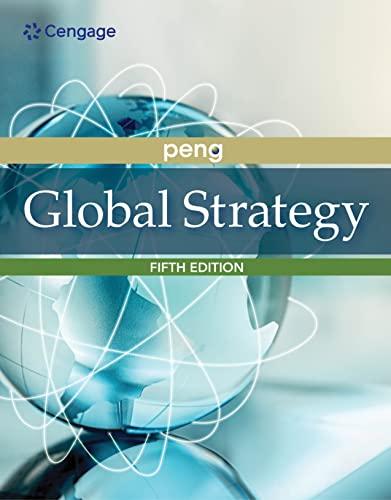In the early 1900s, Danish firms rushed to invest in czarist Russia, building engine factories, cement plants,
Question:
In the early 1900s, Danish firms rushed to invest in czarist Russia, building engine factories, cement plants, and slaughterhouses. Their advanced technologies gave them competitive advantages in the vast Russian market that gradually opened to foreign direct investment (FDI). Then came the Russian Revolution of 1917, and all was lost as these businesses were expropriated. For the next seven decades, Russia had essentially zero FDI.
When Soviet rule came to an end in 1991, Danish firms rushed in again. After all, Russia was the crucial “R” in BRICS (Brazil, Russia, India, China, and South Africa). The world’s fourth largest beer maker, Carlsberg was particularly successful, building a 38% market share and becoming the undisputed leader in Russia. As part of its commitment to Russia, Carlsberg sponsored the national hockey league and the Sochi Olympic Games. In 2013, Russia contributed 35% of Carlsberg’s global revenues.
The success in Russia, however, exposed Carlsberg to its political and economic volatilities. In the 1990s, when Russia was experimenting with democracy, the economy collapsed. By official estimates, GDP fell by approximately 40%. In the early 2000s, the economy was surging at 7% annually, but remained highly volatile. Russia significantly depended on exports of oil and gas, and thus on the world market prices of these commodities. Moreover, as Russia became richer and stronger (in part thanks to high oil prices), the government seemed to become more assertive vis-à-vis foreign firms. For example, the government put pressure on foreign oil companies such as BP to relinquish control over their operations to Russian partners.
While brewing is not a politically sensitive industry, institutional transitions still have a profound impact on Carlsberg. Russian leaders from the czars to Vladimir Putin periodically attempted to convince their citizens to drink less alcohol. As Putin unleashed fresh efforts to reduce alcohol consumption by increasing alcohol tax, the beer market shrank. In addition, new laws banned TV, radio, and outdoor advertising of alcohol. Also banned was the selling of alcohol in street kiosks, which traditionally enjoyed 26% of off-trade sales (retail sales other than those in restaurants, bars, and hotels) of beer in Russia.
Such changes deeply impacted brewers such as Carlsberg in three ways. First, demand surged ahead of the first implementation date of the new tax as consumers stocked up their supplies, only to sharply drop in the next quarter as supplies purchased earlier were gradually consumed. Such ups and downs created enormous stress for logistics and supply chain management.
Second, marketing resources had to be reallocated to, for example, in-store displays and online marketing. Third, constraints on sales channels and advertising shifted the pattern of consumption, leading to sales drops. Then the economic crisis—thanks to the collapsing oil price— further knocked off the demand for beer, especially in the premium segment. By 2014, capacity utilization in Carlsberg’s Russian breweries did not exceed 60%, prompting speculation about possible brewery closures.
In 2014, Carlsberg was hit by the deteriorating Russian economy, worsening geopolitical relationships between Russia and the West, and collapse of the ruble. The trade sanctions imposed by the European Union and the United States did not hit Carlsberg directly, because most of the beer it sold in Russia was made locally. Yet the economic crisis did: Beer consumption dropped, and the value of its Russian investments depreciated when the ruble dropped in value. Therefore, every time there was bad news from Russia, Carlsberg’s share price took a hit. In the second half of 2014, its shares lost 20% value.
Doing business in Russia is never easy. Foreign firms deploy different coping mechanisms. In fear of greater political risk such as the possible introduction of capital controls, some foreign investors such as Danish building materials giant Rockwool divested major assets in Russia. When the ruble collapsed, importers faced grave losses because their sales were invoiced in the ruble but their costs were in a foreign currency. As a coping mechanism, French–Japanese automaker Renault Nissan simply stopped taking orders because it could not appropriately price the cars, which had major imported components. In 2015, Carlsberg reduced capacity by closing two breweries. Despite the challenges, Carlsberg remained committed to Russia, hoping for an economic recovery and a warming up of the geopolitical relationship between its host country and the West.
Political risk aside, Russia’s fundamental strengths remain.
While its GDP is smaller than that of China and Brazil, it is larger than India’s. Russia’s per capita GDP (approximately $16,000 at purchasing power parity) is one-third higher than that of Brazil, three times that of China, and five times that of India. In Europe, Russia not only has the second largest beer market but also the second largest car market (both behind Germany). Worldwide, Russia has more college graduates (as a percentage of population) than any other country, offering a highly educated workforce.
Simply put, Russia may be too big and too rich to ignore.
Case Discussion Questions
1. Why is investment in Russia considered politically risky?
2. Despite the political risk, why do foreign multinationals such as Carlsberg eager to invest in Russia?
3. If you were a Carlsberg board member, would you vote “yes” or “no” for a new project to acquire a local brewery in Russia?
Step by Step Answer:






